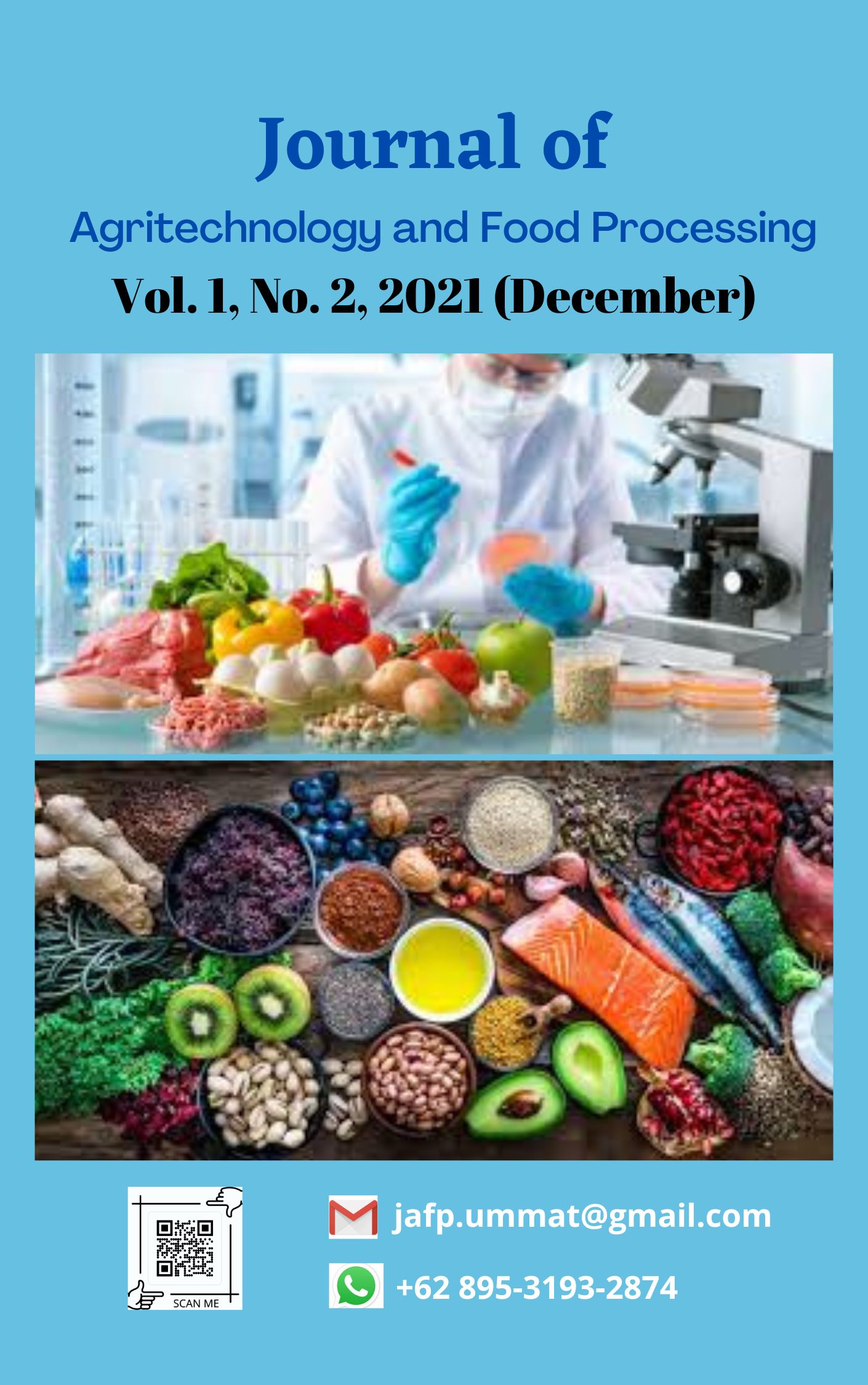Ekstraksi dan Uji Aktivitas Enzim Bromelin Kasar dari Buah Nanas
DOI:
https://doi.org/10.31764/jafp.v1i2.6974Keywords:
Bromelain enzyme, Isolation, Pineapple, TemperatureAbstract
Pineapple (Ananas comosus) is a source of protease enzymes. The protease enzyme present in pineapple is the bromelain enzyme. Bromelain enzymes are widely used in various industrial fields. The purpose of this experiment was to isolate the bromelain enzyme from pineapple plants, to test the activity of the enzyme, and to determine the optimum temperature of the enzyme. Isolation of the bromelain enzyme from pineapple was carried out by precipitating the pineapple fruit filtrate using table salt (NaCl). Then the crude extract of the enzyme obtained was tested on pieces of meat with variations in the testing temperature (room temperature, hot, and cold). The yield of the crude extract of the enzyme obtained from the experiment was 40%. The results of testing the bromelain enzyme activity of pineapple showed that room temperature was the best temperature for the enzyme to tenderize meat compared to hot and cold temperatures.
References
Anggalia, I., & Ginting, Y. (2013). PENGARUH KONSENTRASI DAN CARA APLIKASI IBA (INDOLE BUTIRIC ACID) TERHADAP PERTUMBUHAN BIBIT NANAS (Ananas comosus [L.] Merr.) ASAL TUNAS MAHKOTA. JURNAL AGROTROPIKA.
Bala, M., Ismail, N. A., Mel, M., Jami, M. S., Mohd Salleh, H., & Amid, A. (2012). Bromelain production: Current trends and perspective. In Archives des Sciences (Vol. 65, Issue 11, pp. 369–399).
Ilyas, N. M. (2020). Isolasi dan Karakterisasi Enzim Bromelain dari Bonggol dan Daging Buah Nanas (Ananas comosus). Chemica: Jurnal Ilmiah Kimia Dan Pendidikan Kimia, 21(2), 133. https://doi.org/10.35580/chemica.v21i2.17983
Kumaunang, M., & Kamu, V. (2011). AKTIVITAS ENZIM BROMELIN DARI EKSTRAK KULIT NENAS (Anenas comosus). JURNAL ILMIAH SAINS, 15(1), 198. https://doi.org/10.35799/jis.11.2.2011.207
Kusuma, I., Laksmiwati, A., Arsa, M., & Ratnayani, K. (2015). PERBANDINGAN AKTIVITAS SPESIFIK EKSTRAK KASAR ENZIM BROMELIN BUAH NANAS YANG DIISOLASI DENGAN BEBERAPA JENIS GARAM PENGENDAP. Jurnal Kimia, 9(2). https://doi.org/10.24843/JCHEM.2015.v09.i02.p01
Nurhidayah, N., Masriany, M., & Masri, M. (2013). Isolasi dan Pengukuran Aktivitas Enzim Bromelin dari Ekstrak Kasar Batang Nanas (Ananas comosus) Berdasarkan Variasi pH. Biogenesis: Jurnal Ilmiah Biologi, 1(2), 116–122. https://doi.org/10.24252/bio.v1i2.457
Poba, D., Ijirana, I., & Sakung, J. (2019). Crude Bromelain Enzyme Activities Based on Maturity Level of Pineapple. Jurnal Akademika Kimia, 8(4), 236–241. https://doi.org/10.22487/j24775185.2019.v8.i4.pp236-241
Putri, A. B., & Anita, A. (2017). Efek Anti Inflamasi Enzim Bromelin Nanas Terhadap Osteoartritis. Jurnal Kesehatan, 8(3), 489. https://doi.org/10.26630/jk.v8i3.681
Ramalingam, C.; Islam, N. N. (2012). Isolation and characterization of Bromelain from pineapple (Ananas Comosus) and comparing its anti-browning activity on apple juice with commercial anti- browning. Food Science, 45, 7822–7826.
Salahudin, F. (2011). Pengaruh Bahan Pengendap Pada Isolasi Enzim Bromelin dari Bonggol Nanas. Biopropal Industri, 02(01), 27–31.
Wiyati, P. I., & Tjitraresmi, A. (2018). Karakterisasi, Aktivasi, dan Isolasi Enzim Bromelin dari Tumbuhan Nanas (Ananas sp.). Farmaka, 16(2), 179–185.
Wuryanti, W. (2004). Isolasi dan Penentuan Aktivias Spesifik Enzim Bromelin dari Buah Nanas (Ananas comosus L.). Jurnal Kimia Sains Dan Aplikasi, 7(3), 78–82. https://doi.org/10.14710/jksa.7.3.78-82
Downloads
Published
Issue
Section
License
Authors who publish with this journal agree to the following terms:
1. Authors retain copyright and grant the journal right of first publication with the work simultaneously licensed under a Creative Commons Attribution License that allows others to share the work with an acknowledgement of the work's authorship and initial publication in this journal.
2. Authors are able to enter into separate, additional contractual arrangements for the non-exclusive distribution of the journal's published version of the work (e.g., post it to an institutional repository or publish it in a book), with an acknowledgement of its initial publication in this journal.
3. Authors are permitted and encouraged to post their work online (e.g., in institutional repositories or on their website) prior to and during the submission process, as it can lead to productive exchanges, as well as earlier and greater citation of published work (See The Effect of Open Access).

